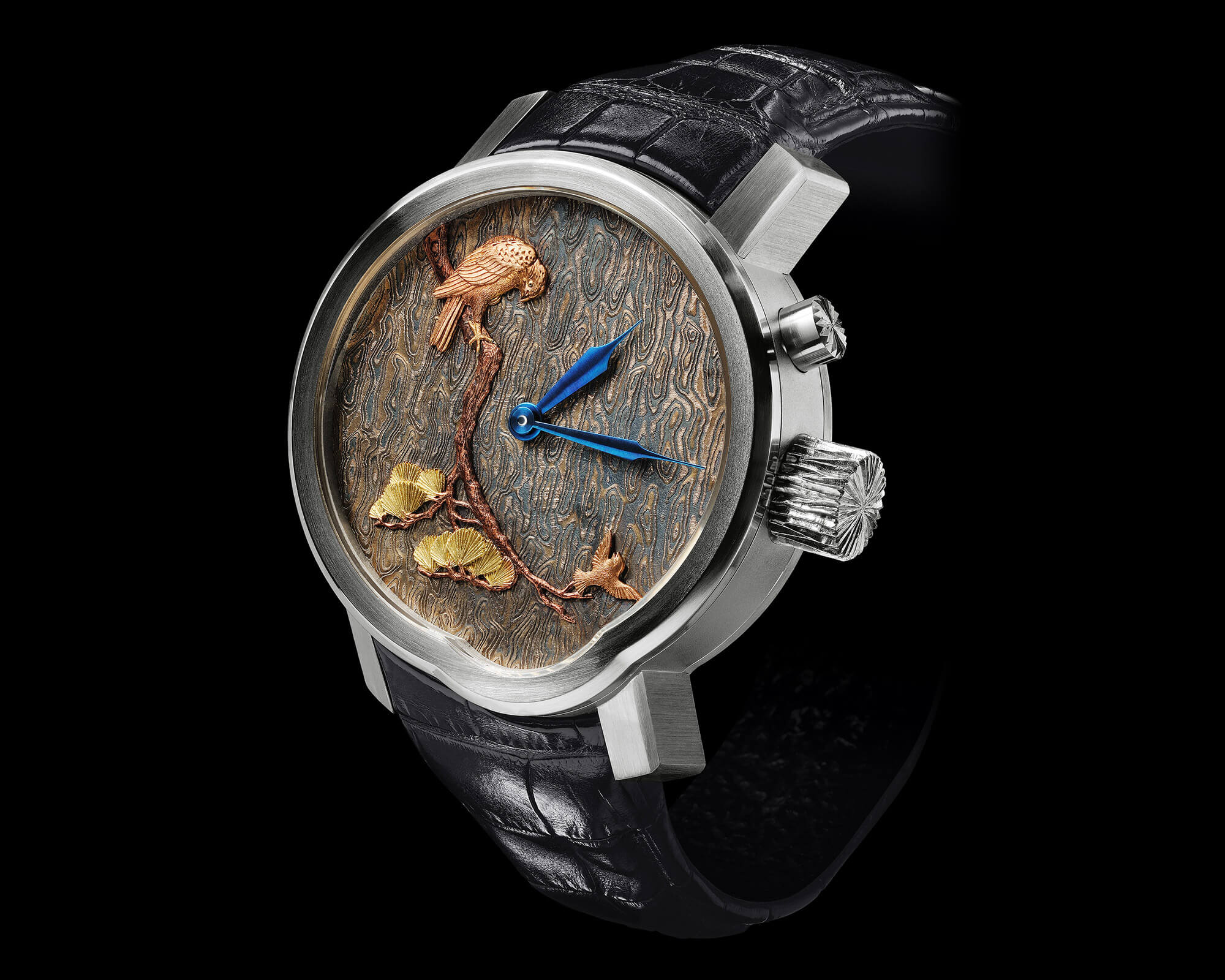There’s an exotic ring to their names: Mokume-gane, Aka-e, Urushi, Maki-e. Japanese ornamental techniques, many of which have all but died out, have found new openings in Swiss watchmaking that haven’t gone unnoticed. Briefly setting aside the traditional companion crafts of gem-setting, enamelling, engraving and engine-turning, half a dozen Swiss brands have joined hands with the great Japanese masters. Revered in their homeland as Living National Treasures, they are the last remaining guardians of these ancient techniques. These often fortuitous collaborations are buoyed by shared affinities, beginning with an almost obsessive attention to detail. The latest example to date is the dial of the Premier Precious Weaving Automatic 36 mm from Harry Winston. It uses Raden, a Japanese weaving technique that blends gold threads with slivers of mother-of-pearl. As well as a commercial success, Swiss watchmakers appear to have found their alter ego in the painstaking traditions of these Japanese practitioners.
A Dutch debut
Kees Engelbarts was almost certainly the first to have introduced Japanese art to Swiss watchmaking. Dutch-born, he moved to Geneva in the late 1980s, having trained as a hand-engraver in the Netherlands and Germany. For his watchmaking debut in 1997 he chose a previously unexplored technique known as Mokume-gane, which literally translated means “wood grain metal”. Various metals are layered then heated, the secret being their different melting points. The resulting laminate bears an astonishing resemblance to natural wood grain. Originally used to make Japanese swords, Mokume-gane is now popular in jewellery. “I learned Mokume-gane while still an apprentice,” he says. “I’ve made maybe twenty trips to Japan but never actually studied the technique there. I do visit colleagues, though, and learn from them.”
It would be another fifteen years before Engelbart’s work gave others ideas. Vacheron Constantin was one. Already a proponent of the métiers d’art, in 2010 it became the first manufacture to showcase Maki-e, whereby the craftsman scatters gold powder onto still wet lacquer to create a pattern: Make-e in fact means “sprinkled picture”. “We were fresh from the Métiers d’Art ‘Les Masques’ collection, which had reverberations well beyond watchmaking circles,” recalls artistic director Christian Selmoni. “Then out of the blue, one of Japan’s oldest lacquer studios, Zôhiko, got in touch with the idea that we work together. And that’s how it all began!” Métiers d’Art ‘La Symbolique des Laques’ took shape over three years. Each year saw the release of a new trio of watches in a limited edition of twenty.
A meeting of minds
The following year, Chopard took its turn to present a Japanese-inspired collection: L.U.C XP Urushi, named after the rare tree that now grows only in Japan and China, and whose sap is used to make the lacquer that forms the base for the Maki-e technique. “A small number of watches had already been produced in 2008 by Master Kiichiro Masumura for an exhibition in Japan,” notes Guy Bove, formerly creative director at Chopard and now a consultant. “The idea was to showcase Chopard watchmaking using something that would strike a chord with the Japanese. We liked them so much, as did the public, that we decided to make an entire collection.” The latest addition, L.U.C XP Hurushi ‘Year of the Monkey’, was presented at this year’s Baselworld.
In Japan and Switzerland, the atmosphere in the workshops is the same. Time no longer exists.
Though an advocate of the purist Swiss watchmaking tradition, Kari Voutilainen has also embraced Japanese techniques. In 2011, he presented the result of the first collaboration between his workshop in Val-de-Travers and the Unryuan studio in Wajyma, a tiny fishing village, east of Tokyo. The studio, under Living National Treasure Tatsuo Kitamura, perpetuates the art of Maki-e. However, in addition to powdered gold and lacquer, its artists work with gold leaf (Jyunkin-itakane), green sea snail shell (Yakou-gai) and New Zealand abalone shell (Awabi-gai). The result is iridescent micro-mosaics of which no two are the same. “I taught at WOSTEP between 1999 and 2002. One of the programme’s Japanese students introduced me to Tatsuo Kitamura,” Kari Voutilainen explains. “If I’d just picked up the phone, he would never have agreed to see me. You have to be recommended.” This initial contact blossomed into mutual respect; the two men have produced six creations together to date. “What’s important to me are the ethics and the wonderful values behind this Japanese art. This explains why the atmosphere in our two workshops is so similar. Time no longer exists.”
A question of tradition
The Slim d’Hermès Koma Kurabe, presented in 2015, owes its existence as much to an unexpected invitation as a mutual interest in others’ work. “In 2010, a small delegation from Hermès travelled to Kanazawa, at the Japanese authorities’ behest, to discover local crafts,” recalls artistic director Philippe Delhotal. “It was during this trip that I made the acquaintance of Master Buzan Fukushima, a specialist in Aka-e which is the Japanese art of painting on porcelain. I asked him if he would be interested in making watch dials, and he was most honoured.” It would take a further two years, and extensive research, before Sèvres porcelain, less porous than its Japanese counterpart, was finally chosen as a support. The pigment, which is obtained from crushed iron oxide, takes on the distinctive Terre de Sienne colour. Master Fukushima recreated a scene from the Koma Kurabe horse race, which is held once a year at the Kamigamo Shrine, founded in 678 in Kyoto.
Despite the language barrier, we're more in tune than we are with an electroplating firm just down the road.
While the popularity of the métiers d’art in horology has helped revive certain forgotten techniques, watchmakers have also shown what Guy Bove calls “an open mind” and explored more distant horizons. And Japan was only too happy to welcome them. “I was immediately struck by the attention to detail and the quality of the craftsmanship. It’s quite astounding,” enthuses Kari Voutilainen. Christian Selmoni confirms: “The Japanese didn’t speak English, we didn’t speak Japanese, and yet we were more in tune than ever we could be with an electroplating firm just down the road. It was a truly enriching experience.” And for both sides, as “working with Swiss watchmakers is one way for them to perpetuate their traditions.”
























